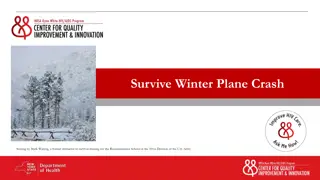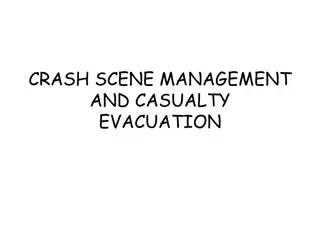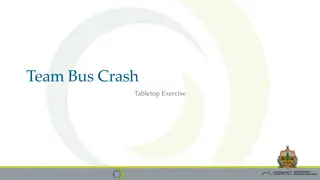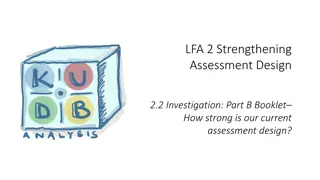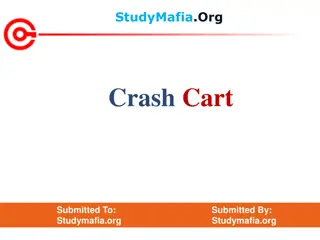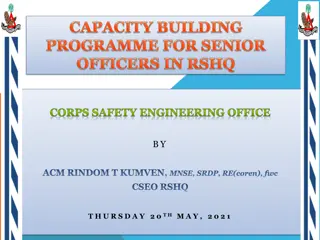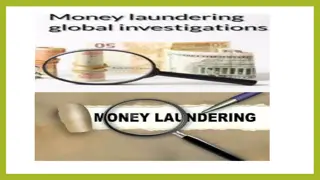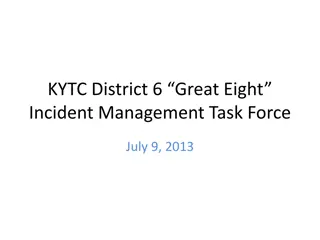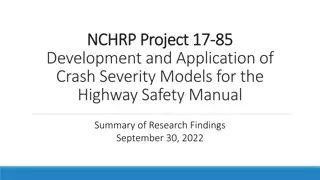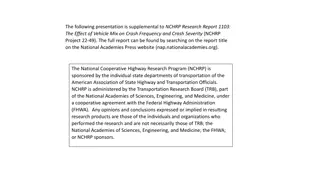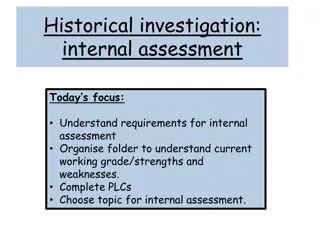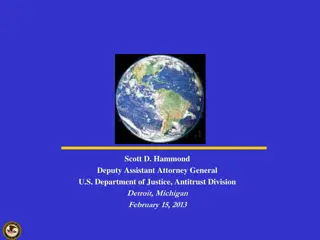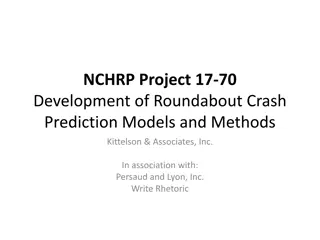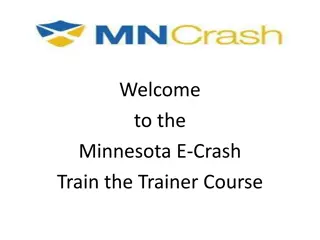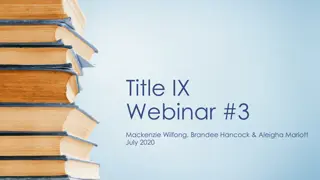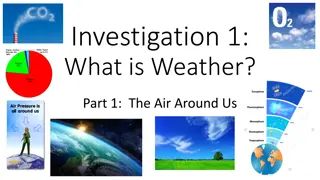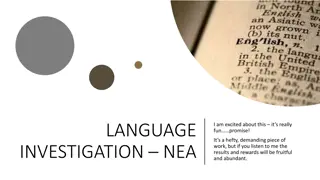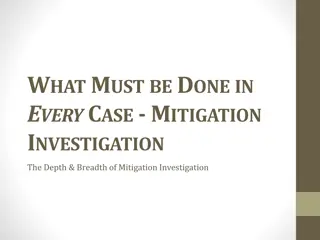Understanding Crash Investigation Procedures
Crash investigation is a crucial element in incident management at crash scenes. It involves determining the cause and details of traffic crashes, with collected information used by various stakeholders such as traffic engineers and insurance companies. Law enforcement officers play a vital role in completing crash reports to support safety measures. The aim of crash investigation is to introduce participants to road crash investigation procedures, including elements and objectives to be able to explain what road crash investigation is, its elements, and procedures. Through a systematic inquiry, the truth behind vehicle collisions is established.
Download Presentation

Please find below an Image/Link to download the presentation.
The content on the website is provided AS IS for your information and personal use only. It may not be sold, licensed, or shared on other websites without obtaining consent from the author. Download presentation by click this link. If you encounter any issues during the download, it is possible that the publisher has removed the file from their server.
E N D
Presentation Transcript
CONCEPT AND CONDUCT OF CRASH INVESTIGATION
INTRODUCTION Crash investigation is an important element in the entire incident management process at a crash scene. It is an effort to determine how the crash occurred. Investigation is required to document the cause and description of traffic crashes.
INTRO CONTD Information that is collected during a crash investigation which is similar, can be used by traffic engineers improvement in crash information may also be used by insurance companies to provide information for litigation purpose. to support safety The prone areas.
INTRO CONTD After a crash has occurred, law enforcement officers(Police, FRSC and VIO)with their unique report form are required to complete a crash report form. The purpose of this procedure is to collect information regarding the nature and cause of crash,thus the Concept and Conduct of Crash Investigation.
AIM The aim of this lecture is to introduce the course participants to procedure of Road Crash Investigation. The Elements and
OBJECTIVES At the end of this lecture, the participants are expected to be able to explain the following; 1.What Road crash investigation is 2.Elements of Road crash 3.procedures of Road crash investigation
WHAT IS ROAD CRASH INVESTIGATION? Crash- Collide violently with an obstacle or another vehicle. Investigate- Carryout a systematic or formal inquiry into (an incident or allegation) so as to establish the truth. (Concise Oxford Dictionary). Crash Investigation can be defined as a procedure in carrying out a systematic inquiry into vehicle collision with an obstacle or another vehicle, so as to establish the truth.
ELEMENTS OF ROAD CRASH INVESTIGATION In crash investigation, crash reporting is the first level. The FRSC staff report officially events surrounding a crash. The accuracy and completeness of the report will depends on the quality of an officer investigating and his attention to details.
ELEMENTS OF ROAD CRASH INVESTIGATION CONTD However, there are five types of evidences from the roadway; 1.Final resting positions of made by a tire that is locked and is not free to rotate vehicles and bodies, which could be controlled that is final resting position as done by the driver and uncontrolled as propelled by law of physics. 2.Tire Marks that consist of three categories namely (i)skids made by a tire that is locked and is not free to rotate, which can be skip, gap or curved skids with following evidences
ELEMENTS OF ROAD CRASH INVESTIGATION CONTD -The location and direction of travel for the vehicle. -The drivers intention to slow or stop. -Provides possible evidence as to the speed of the vehicle. -Helps define area of impact by way of offsets in the skid. (ii)Yaw marks are made by tires freely rotating but also sliding to the side, with the following evidences -The vehicle was traveling too fast to negotiate the curve. -The vehicle's location and direction on the roadway. -The driver's intention was not to stop but rather to steer. -Very accurate in determining speed of vehicle.
ELEMENTS INVESTIGATION CONTD (iii)Tire prints are caused by tires rotating in normal fashion and freely. Tire prints are typically seen when a vehicle s wheels travel through soft material or fluid (slush, sand, or snow). As evidence, tire prints can illustrate: -The location and direction of the vehicle. -The drivers intention was not to brake, and it may indicate that the driver was on steering OF ROAD CRASH
ELEMENTS INVESTIGATION CONTD (3)Gouge Marks,although sometimes called by different names, a gouge mark is a physical damage caused to the road when some parts of the vehicle strikes the roadway. (4) Debris is the most common type of physical evidence found at the scene of a crash. Debris refers to broken parts, dirt, or fluid dislodged from the vehicle during the impact. (5)Damage to roadside objects: Damaged objects such as trees, mailboxes, ditch culverts, signs, fences, and other structures can help officers understand events that have occurred. OF ROAD CRASH
PROCEDURES OF CRASH INVESTIGATION In carrying out crash investigation, there are some steps to be taken in order to achieve the desired goal. They are as follows: 1. Establishing a reference point(s) is a permanent location that officers or someone else can locate at the scene. This point can be a tangible reference point when there is a fixed object or landmark already at the scene like Fire hydrants, Utility poles, Bridges, Building etc. And Intangible reference points are those which the officer places at the scene and must be related to and measured from a tangible reference point. Examples of intangible reference points are: Points at which extended curb lines intersect. It is marked on the roadway with chalk or paint.
PROCEDURES OF CRASH INVESTIGATION CONTD 2. Measurement: After the reference points (RP) have been determined, officers need to take measurements. Equipment needed to take measurements are: a.Two measuring tapes - one at least 100 feet and one 25 feet. Steel tape is the most accurate because it does not stretch, like fabric or fiberglass tape. However, steel tape will rust once wet. b.Wheel tape. These can be used on smooth surfaces, but make sure that the wheel stays in contact with the ground at all times.
PROCEDURES OF CRASH INVESTIGATION CONTD However, There are six methods used to take measurements: The coordinate method which measurements(distance and direction) from a reference point and the triangulation method though complex but more preferred, practical and appropriate in absence of good reference point, are common ones. Other methods include Total station survey equipment, Aerial photograph, Laser range finder system, A global positioning system(GPS) based system. involves taking two
PROCEDURES OF CRASH INVESTIGATION CONTD 3.Field Sketch being one of the procedural steps to be taken in order to achieve the desired goal in road crash investigation, is an important tool for crash scene investigators. Typically not drawn to scale, but the diagrams that can help officers illustrate evidence and re-create future drawings needed for the Crash Report. CONCLUSION Investigating a collision requires more than checking boxes on a form. Officers must recognize, preserve, and collect all relevant evidence. They must also document the event thoroughly, possibly for others not present, so they can fully understand what happened. The investigation of traffic collisions is one of the most common in law enforcement activity. Many times it involves the least serious crimes, with the most serious consequences. The dedication and commitment exercised by the investigator could mean the difference between an investigation and a report.





